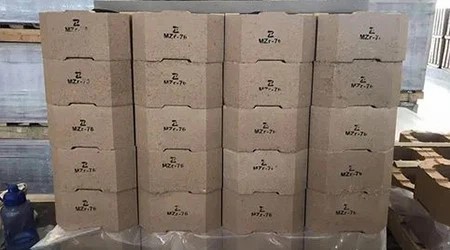PRODUCTS
Magnesia Zirconia Brick
High purity fused magnesite and synthetic sintered magnesia are used to make magnesia zirconia brick, which exhibits exceptional erosion resistance against alkali metal, oxide, and sulfide after being formed under high pressure and fired at high temperatures. The bulk density of the magnesia zirconia bricks is more than 3.08g/cm3. It is frequently used in glass furnaces, regenerative chambers, cement kilns, electric steelmaking furnaces, and nonferrous metallurgy smelting because it is resistant to alkaline erosion environment basic slag corrosion. 2715C is the melting point of magnesia-zirconi
Composition: Premium materials such as high alumina oxide, magnesium oxide, and silicon carbide, with customizable composition based on client requirements.
Form: Available in powder, brick, board, and castable forms to suit various application needs.
Refractoriness: Standard range from 1200°C to 1800°C, with options for higher temperature customization.
Application Fields: Widely used in industries such as steel, cement, glass, and petrochemicals for furnace lining and insulation.
Packaging: Options include 25 kg bags, bulk bags, and custom packaging solutions compliant with global transportation standards.
Introduction
Our experienced R&D team can customize the material, form, and size according to your specific application needs while ensuring compliance with international quality standards. With rigorous quality control and advanced production facilities, we guarantee products with high refractoriness, excellent compressive strength, and long-lasting durability. Whether you are in the steel, cement, glass, or petrochemical industry, we are your trusted partner, supporting the success of your projects.
For customization inquiries, please feel free to contact us. We will provide tailor-made solutions based on your requirements.
Magnesia Zirconia Brick Details
High purity fused magnesite and synthetic sintered magnesia are used to make magnesia zirconia brick, which exhibits exceptional erosion resistance against alkali metal, oxide, and sulfide after being formed under high pressure and fired at high temperatures. The bulk density of the magnesia zirconia bricks is more than 3.08g/cm3. It is frequently used in glass furnaces, regenerative chambers, cement kilns, electric steelmaking furnaces, and nonferrous metallurgy smelting because it is resistant to alkaline erosion environment basic slag corrosion.
2715°C is the melting point of magnesia-zirconium bricks. Only when the temperature of 1660°C is exceeded can clinker be corroded. Therefore, one of its advantages is that its refractoriness is higher than other bricks. Zirconia also has greater fracture strength under hot and cold conditions. This is due to the micro-cracks around its particles that absorb external stress.
At the same time, magnesia-zirconium bricks can also resist harmful corrosion such as SO3, CO2, alkali chlorine vapor, etc. They are also very resistant to clinker liquid phase corrosion, and have high compressive strength and resistance to oxidation and reduction atmospheres. Advantages, but magnesia-zirconium bricks have a high expansion coefficient and poor structural toughness, and are prone to cracks and peeling damage during application.
Features
1.Alkali resistance.They are considered alkaline refractories, meaning they are resistant to alkaline chemical attack.
2.Resistance to slag
3.The spalling resistance
4.High Temperature Resistance: They can withstand extremely high temperatures, making them suitable for use in environments with temperatures well above 2,000 degrees Celsius.
Application
1. Steel Industry:
- Furnace Linings: The walls of steelmaking furnaces, such as basic oxygen furnaces (BOFs), electric arc furnaces (EAFs), and ladle furnaces, are lined with magnesium zirconium bricks. They offer resistance to corrosive substances like molten steel and slag as well as high temperatures.
2.Glass Manufacturing:
- Glass Melting Tanks: In the glass industry, these bricks are used to build the walls and floors of glass melting tanks and regenerators. They can endure the high temperatures and harsh chemicals used in making glass.
3. Cement Industry:
- Rotary Kilns: Magnesium zirconium bricks are used to line the interior of rotary kilns in cement plants, where raw materials are processed and clinker is produced. The bricks offer high-temperature resistance and resistance to alkali attacks.
4. Non-Ferrous Metals Industry:
- Copper and Aluminum Smelters: These bricks can be used in the lining of smelting furnaces for copper and aluminum production, where high temperatures and corrosive materials are encountered.
5. Petrochemical Industry:
- Petrochemical Reactors: In some high-temperature, chemical reaction vessels and reactors used in the petrochemical industry, magnesium zirconium bricks may be employed to resist heat and chemical corrosion.













